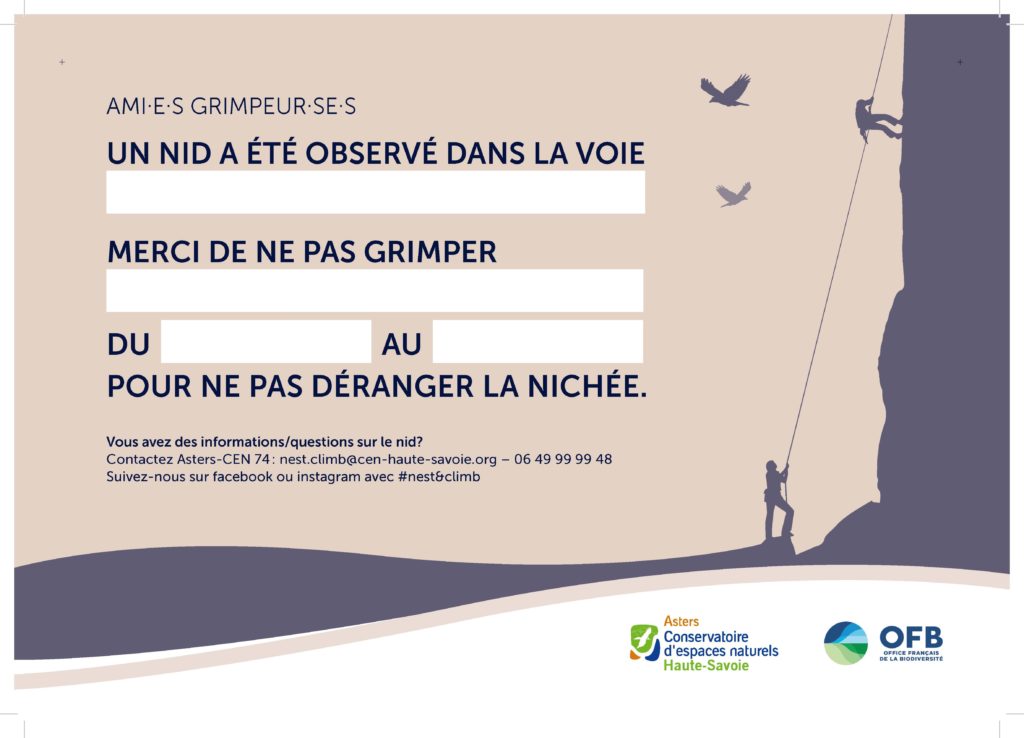Case study: Nest&Climb, a participatory monitoring of birds’ nests in climbing areas
Photo by Flo Maderebner from Pexels
We always need to remember that out in nature we are guests, visiting habitats and environments populated by many different species. While practicing outdoor sports, we need to pay attention to what we do and how we do it, doing our best to respect the surroundings. This is exactly what the”Nest&Climb” project, developed in the Haute-Savoie region, is all about. It focusses on participatory monitoring of birds’ nests in climbing areas.
Nest&Climb
The Haute-Savoie region in France is rich in nature reserves and wildlife, including many species of rupestrian birds. In 2021, Asters-Conservatory of Natural Espaces of Haute-Savoie, supported by the French Office of Biodiversity, launched the project Nest&Climb to reconcile the practice of sport climbing with the protection of birds nesting on cliffs.
Monitoring and protecting birds’ nests in climbing areas
Nest&Climb aims to educate and raise climbers’ awareness on bird species they share the crags with. Additionally, it was developed to support the environmental monitoring of climbing areas. This is essential for ensuring sustainable management of outdoor areas and climbing activities.
The area would ban certain climbing routes to allow birds to nest during a specific period of time, however often lacked to proper information to determine these areas. To gather the data needed, the Haute-Savoie region decided to collaborate with different climbers, the local authority managing the site, the Natura 2000 manager and local municipalities .
There are over 150 bolted cliffs in Haute-Savoie, and climbers were called upon to report nests they noticed on the cliffs to support the monitoring efforts.
Challenges
At the beginning there was a lot of work to do, with more than 20 nests being reported in as many crags. Identifying birds is a delicate process, as it’s important to not disturb the animals. Additionally, sometimes the spots chosen by birds to nest are hard to reach and mark (with explanatory signs). There was also the initial fear of the project not being welcomed by the climbers because it could have been perceived as a threat to their freedom. However, Nest&Climb turned out to be a success and was well-received by climbers.
Solutions and Actions
To tackle the need for more information and action, the Haute-Savoie region started:
- Developing educational content about the different bird species and nesting periods
- Using social media accounts to share this knowledge, and to collect information about reported nests
- Creating a community of several hundred climbers interested in helping with the issue
- Asking climbers to report birds’ nests, then identify the birds and warn other users of the area about it with signs explaining the nesting period and the routes that should not be climbed during that period of time
- Making sure the nests are actually occupied before banning the routes for only a short period of time. It has made the bans more acceptable by making sure the nests are actually occupied before banning the routes for only a short period of time.

Sign to be put on routes that host a nest. Design by Benoit Favre.
Outcomes
Nest&Climb has been successful and promising, showing that outdoor activities enthusiasts are willing to participate and contribute to the preservation of the surrounding environment and are ready to learn about it.
For more info on Nest&Climb visit the Facebook page
Good practices in Outdoor Sports
Being out and active in nature requires a level of respect. As guests, we will inevitably create an impact. It is our responsibility to minimise harmful effects, so that we can continue enjoying nature in a harmonious way.
In 2019, the EUROPARC Federation and the European Network of Outdoor Sports (ENOS) launched the 10 Good Principles for Outdoor Sports in Protected Areas (PAs) These Principles aim to promote good conduct among outdoor sports practitioners. It is available in multiple languages and we encourage Protected Areas and outdoor sports networks to use and promote them!

SEE logo
Sustainable Education in Outdoor Sports
EUROPARC is also part of the Erasmus+ SEE Project (Sustainability and Environmental Education in Outdoor Sports). The projects looks at challenges of outdoor sports across Europe and trains outdoor sports trainers in good practice, to allow increased participation so that more people can enjoy the recognised benefits of Health Enhancing Physical Activity in the outdoors.
Read more about the SEE project partners, approaches and goals
Follow the project updates on Instagram @see_project_eu